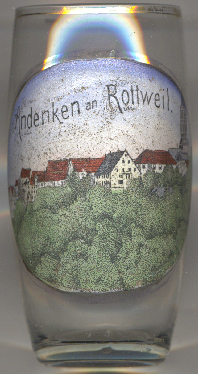

|
| DEUTSCHLAND | GERMANY |
| Bundesland: Baden-Württemberg | |
| Regierungsbezirk: Freiburg | |
| Landkreis: Rottweil |
 Rottweil is situated at an elevation of 599 m on the river Neckar between the
Schwäbische Alb and Schwarzwald (Black Forest) mountain regions.
Rottweil is situated at an elevation of 599 m on the river Neckar between the
Schwäbische Alb and Schwarzwald (Black Forest) mountain regions.
The Romans built a settlement called Arae Flaviae in 73 AD. This settlement was the centre of a 'civitas', a district, and had the status of a 'municipium'. With a surface area of 18 hectares it was one of the largest Roman towns in southern Germany. The name Arae Flaviae had been known since the discovery in 1507 of the Tabula Peutingeriana. However, it took until 1950 that Rottweil was identified as the site of this place. Arae Flaviae was practically abandoned after the Romans lost control of the region in 159/260. During the Middle Ages the place became the site of an Alemannic ducal seat, which was first mentioned in 771 as Rotuvilla. During the Carolingian times the residence was an important court of law of the empire. During the period of the Hohenstaufen dynasty, the new town of Rottweil was founded on an elevated plateau above the river, about 2 km west of the old Roman town.
 In 1434 Rottweil obtained the status of a free Imperial city. In 1436 the city joined into a union wit the
Swiss Confederation. This union was meant to be temporary, but was made permanent in 1519. Thus, the town had the
status of an associate (Zugewandter Ort) of the Confederacy.
In 1802 Rottweil was finally taken by the duchy (1806 Kingdom) of Württemberg. This de facto ended the union with the
Swiss Confederation, although it never was revoked formally.
In 1434 Rottweil obtained the status of a free Imperial city. In 1436 the city joined into a union wit the
Swiss Confederation. This union was meant to be temporary, but was made permanent in 1519. Thus, the town had the
status of an associate (Zugewandter Ort) of the Confederacy.
In 1802 Rottweil was finally taken by the duchy (1806 Kingdom) of Württemberg. This de facto ended the union with the
Swiss Confederation, although it never was revoked formally.
The three small pictures on glass no. 1948 [near left] show (from left to right):
 Hauptstraße (Main Street),
Hauptstraße (Main Street),
the  Pulver-Fabrik (powder factory),
Pulver-Fabrik (powder factory),
and the  Studienheim (students' home).
Studienheim (students' home).
The oldest mention of a powder mill dates from 1564, but its tradtion seems to go back to the 15th century.
A first powder factory was founded in 1817 but was destroyed by an explosion in 1839. A second powder factory
was founded in 1840. In 1853 this factory was acquired by the pharmacist Wilhelm Heinrich Duttenhofer. Already
by 1859 the company was the largest producer of gunpowder in Württemberg. In 1918 the factory was partly converted to
the production of synthetic fibres. The old factory buildings survived World War II almost without damage.
In 1945 the powder manufacturing site within the factory complex was demolished by the French occupation forces.
The production of synthetic fibres continued until 1994.
![[scale]](lineal.jpg)